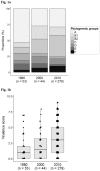Phylogenetic, virulence and antibiotic resistance characteristics of commensal strain populations of Escherichia coli from community subjects in the Paris area in 2010 and evolution over 30 years
- PMID: 26822436
- PMCID: PMC6365622
- DOI: 10.1099/mic.0.000242
Phylogenetic, virulence and antibiotic resistance characteristics of commensal strain populations of Escherichia coli from community subjects in the Paris area in 2010 and evolution over 30 years
Abstract
It is important to study commensal populations of Escherichia coli because they appear to be the reservoir of both extra-intestinal pathogenic E. coli and antibiotic resistant strains of E. coli. We studied 279 dominant faecal strains of E. coli from 243 adults living in the community in the Paris area in 2010. The phylogenetic group and subgroup [sequence type complex (STc)] of the isolates and the presence of 20 virulence genes were determined by PCR assays. The O-types and resistance to 18 antibiotics were assessed phenotypically. The B2 group was the most frequently recovered (34.0 %), followed by the A group (28.7 %), and other groups were more rare. The most prevalent B2 subgroups were II (STc73), IV (STc141), IX (STc95) and I (STc131), with 22.1, 21.1, 16.8 and 13.7 %, respectively, of the B2 group strains. Virulence factors (VFs) were more common in B2 group than other strains. One or more resistances were found in 125 strains (44.8 % of the collection) but only six (2.2 % of the collection) were multiresistant; no extended-spectrum beta-lactamase-producing strain was isolated. The C phylogroup and clonal group A strains were the most resistant. No trade-off between virulence and resistance was evidenced. We compared these strains with collections of strains gathered under the same conditions 30 and 10 years ago. There has been a parallel and linked increase in the frequency of B2 group strains (from 9.4 % in 1980, to 22.7 % in 2000 and 34.0 % in 2010) and of VFs. Antibiotic resistance also increased, from 22.6 % of strains resistant to at least one antibiotic in 1980, to 31.8 % in 2000 and 44.8 % in 2010; resistance to streptomycin, however, remained stable. Commensal human E. coli populations have clearly evolved substantially over time, presumably reflecting changes in human practices, and particularly increasing antibiotic use.
Figures


References
-
- Bailey JK, Pinyon JL, Anantham S, Hall RM. Commensal Escherichia coli of healthy humans: a reservoir for antibiotic-resistance determinants. J Med Microbiol. 2010;59:1331–1339. - PubMed
-
- Bengtsson S, Naseer U, Sundsfjord A, Kahlmeter G, Sundqvist M. Sequence types and plasmid carriage of uropathogenic Escherichia coli devoid of phenotypically detectable resistance. J Antimicrob Chemother. 2012;67:69–73. - PubMed
-
- Benjamini Y, Hochberg Y. Controlling the false discovery rate: a practical and powerful approach to multiple testing. J R Stat Soc Ser B Methodol. 1995;57:289–300.
Publication types
MeSH terms
Substances
LinkOut - more resources
Full Text Sources
Other Literature Sources
Medical

